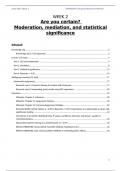Zusammenfassung
Summary Week 2. Moderation, mediation & statistical significance - KNOWLEDGE CLIP, LECTURE, WORKGROUP + LITERATURE SUMMARIES
- Kurs
- Hochschule
This document contains my notes of the knowledge clip, my notes of the lecture, my notes of my workgroup meeting & summaries of the mandatory (and 2 extra) literature.
[ Mehr anzeigen ]



